Why BTC Miners Are Important
BTC mining corporations are extremely important for the future of Bitcoin, as a currency, ecosystem, and store of value. In a previous article, talking about why I still believe it is worthwhile investing in crypto assets (click on this link to read the full version), I shared three assumptions behind my investment thesis:
- Bitcoin Halving Event – The ecosystem is preparing for another big halving event, scheduled on May 2024 – this is the point in time when the BTC rewards get cut in half. This means that miners, investing in the process of generating new BTC, will get rewarded less. This makes BTC less liquid in the market and more difficult to mine.
- Miners Accumulation – As miners get more access to traditional sources of capital, they can hold on their BTC rewards. This makes BTC even more liquid and thus scarce in the market.
- Institutional Acceptance – The more institutional investors use BTC as a store of value, the higher the price, the less BTC will be available on the market.
Today, I want to zoom in assumption number 2. Why? Because this is a critical assumption. I believe this is the biggest domino piece that will trickle down the rest. If mining corporations are not able to survive the recession we are in, the halving event will be less effective. With a weak mining infrastructure, BTC price will remain volatile and unpredictable. This will not attract enough volume and interest from institutional investors. And the whole cycle reverses in a negative spiral.
So let’s take a look at how mining corporations are actually doing. And, most importantly, whether they can survive this recession and possible market crash. And if not, what needs to happen for them to survive? May 2024 is 29 months away as of this article (August 2022).
Also, at the time of this article, BTC/USD = 23.211.
The BTC Mining Corporations We Will Look At
I have selected some of the largest, stock-listed, mining corporations as a proxy of the market. My assumption here is simple: if these can’t make it, we have a problem, Houston. Then even if a small privately-owned miner survives, the ecosystem is not heathy enough to scale! So, for my theory to work, it is important to understand their chances at survival.
Here are the mining corporations I selected for today’s article.
Bitfarms (BITF)
Bit Digital (BTBT)
Digihost Technologies (DGHI)
Marathon Digital (MARA)
RIOT Blockchain (RIOT)
Stronghold Digital (SDIG)
Voyager Digitaal (VYGVF)
Note: only one of these miners is in my portfolio (let’s see if you can guess which one – leave a message below!). So this article is purely a market study to understand how the industry is actually doing! All the information shares in this article is taken from Yahoo Finance and annual reports (I also added the links, if interested!).
Bitfarms (BITF)
Annual Report – https://bitfarms.com/investors/#reports-and-filings
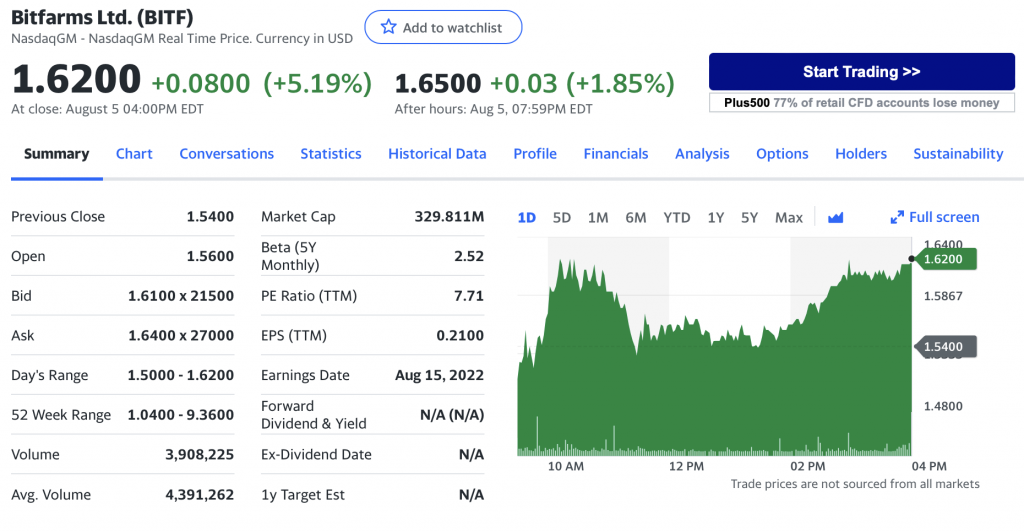
Bitfarm is a large Bitcoin miner (I believe 3rd in the world at the time of this writing) with a total of 9 data centers in Canada, United States, Paraguay, and Argentina for a total of 35.700 machines and a processing speed of 3,4 EH/s. For the coming half a year, they are planning on doubling down on their infrastructure adding another 35.000 machines across their data centers to achieve a processing speed of 6 EH/s.
With their infrastructure and algorithms, they can mine Bitcoins at $ 8.700 (37,5% of current Bitcoin price). The operational margins are slightly below average, but what is really surprising is that Bitfarms is (probably) the only mining company with profits in 2021! I say probably because I cannot be certain to have analyzed them all. But out of all the top players (in the public sectors), Bitfarms has remarkably efficient operations!
Next to their cash position of $ 42 million, Bitfarms has sold 3.000 BTC in this first half year, adding another $ 62 million to their liquidity. Part of the extra liquidity is used to repay some short-term loans, bringing down their credit facility to $ 38 million. The total liquidity is estimated above $ 400 million, including a $ 328 million of shares they can deploy in the market.
The liquidity is enough to finance the additional infrastructure planned for the coming half a year and operational costs for the coming 16 months.
Bit Digital (BTBT)
Annual Report – https://bit-digital.com/investors/financial-information/
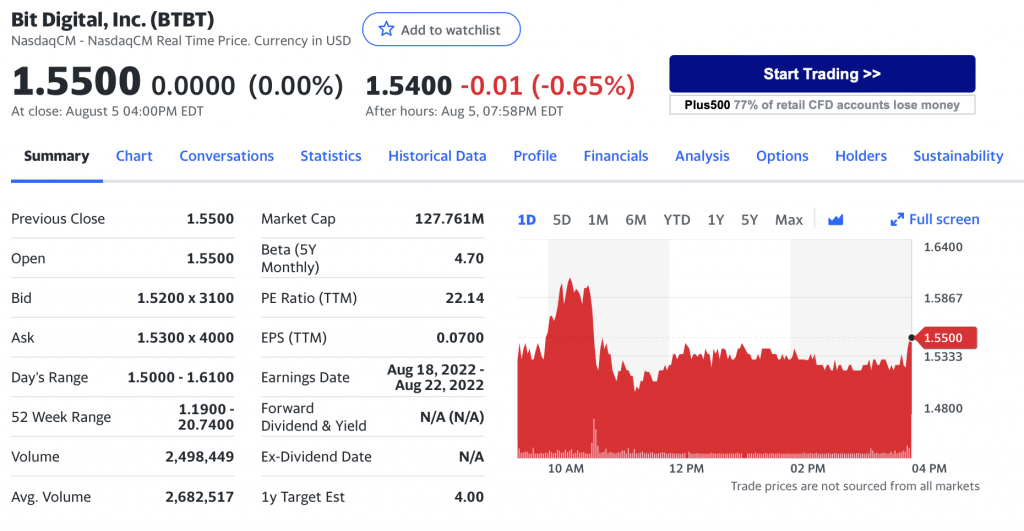
Bit Digital is a Chinese BTC mining company. In 2021, they managed to react quickly to the anti-BTC policies in China and move their operations to the USA. They currently own infrastructure in Nebraska, Texas, Georgia, and the state of New York.
The move to the United States posed a huge challenge and forced them to stop operations since 2021. As of March 2022, they managed to get 40% of their infrastructure up and running. So a bit more patience before Bit Digital gets back to full force!
Current cash position is $ 49 million, for a run-way of 22 months. This is assuming they will not make heavy investments in new machinery as part of their process of establishing their operations in the US.
Digihost Technologies (DGHI)
Annual Report – https://sec.report/Ticker/DGHI

Digihost Technologies is one of the smallest miners in the industry, but very innovative in how they source energy using natural resources. It has recently reached a processing speed of 1 EH/s and can mine at a low price point of $ 6.669/BTC (28%).
What I find interesting in Digihost Technologies, and the second reason why I am invested in them, is their large cash position of $ 258 million (including cash and at-the-market shares). This gives them a run way of 47 months. That is enough to survive until the next Bitcoin halving! With zero additional capital injection, share dilution, or corporate loans.
Marathon Digital (MARA)
Annual Report: https://ir.marathondh.com/sec-filings
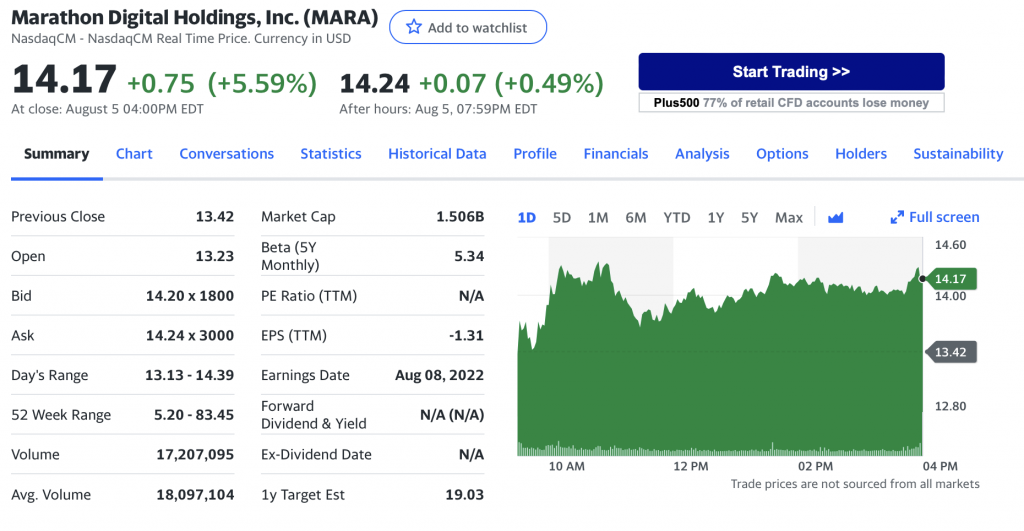
Marathon Digital is one of the healthiest Bitcoin miners in terms of capital structure. They are large enough to be able to finance growth and new infrastructure with own capital, without having to sell off their BTC position. Their current cost structure is also very interesting: the cost of mining 1 BTC is only $ 6.765, that is ca. 30% of the current BTC price compared to the industry average of 50%!
This crazy cost efficiency is due to the fact that MARA has invested a lot in a newer infrastructure in the 2020-2021 period. They own almost 40.000 machines, processing 3,9 exa-hash per second (EH/s). To put this into perspective, this amounts to 1,9% of the WORLDWIDE hash-processing capacity. By 2023, the company is expected to reach an infrastructure with close to 200.000 machines, reaching a processing speed of 23 EH/s!
MARA reported a cash position of $ 86 million, excluding a principal repayment expected by end of 2022 of an additional $ 30 million. Total cash position is therefore $ 116 million. This would cover 4-5 months of company expenses, to maintain the current level of expansion and infrastructure growth. This is why, to bridge the gap until the Bitcoin halving event in May 2024, MARA will most likely sell part of their BTC position in the near term, or will have to attract new streams of capital.
I do not think it is reasonable to assume that a 6x increase in processing power will lead to a 6x increase in revenue. The space is becoming very competitive, and mining BTC becomes increasingly difficult as a result of that. So I would be conservative and assume they could increase their revenues at the same pace BTC price raises. Additional value of course is created in a bull market (with higher multipliers) and speculative capital.
RIOT Blockchain (RIOT)
Annual Report – https://www.riotblockchain.com/investors/sec-filings/
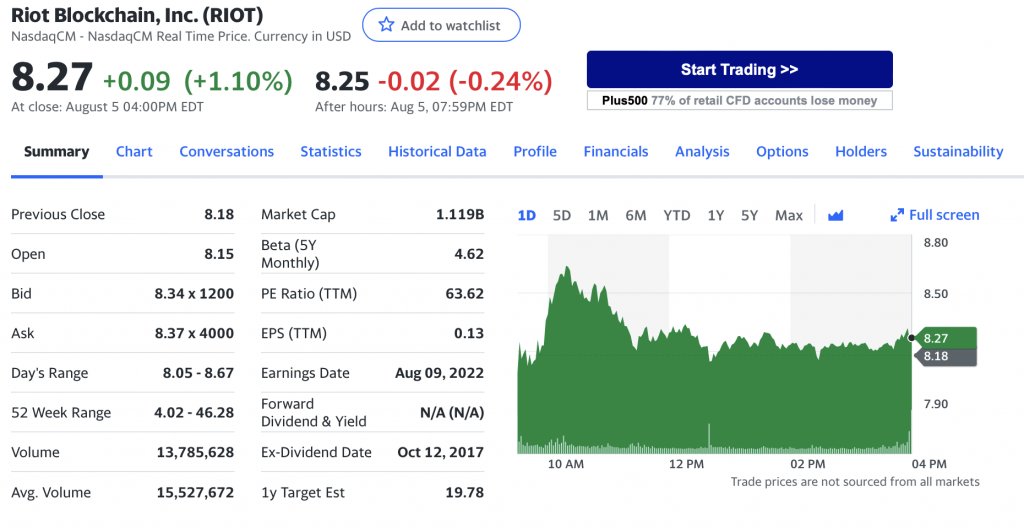
In the US, they made the news with the largest mining infrastructure ever built in Whinstone, Texas. Their cost structure however is closer to the market average, with the company spending close to $ 13.600 for every mined BTC (~60%). This is double the cost structure of MARA!
RIOT expects to bring costs down to $ 4.570/BTC (20% at current price) with the latest infrastructure renewal planned for the next 12 months.
RIOT Blockchain is one of the largest miners in terms of processing speed, with 4,3 EH/s, and a market capitalization of ca. $ 1.150 million as of this writing.
According to my research, RIOT has a cash position of $ 462 million and a total credit facility of $ 500 million provided by investment banks. Including the entire credit facility, the company could afford to pay for expenses and growth for the next 10 months.
The future growth of the company is EXTREMELY dependent on the next infrastructure renewal to improve operational margins. If we run the scenarios, it will be clear why.
Stronghold Digital (SDIG)
Annual Report – https://sec.report/CIK/0001856028
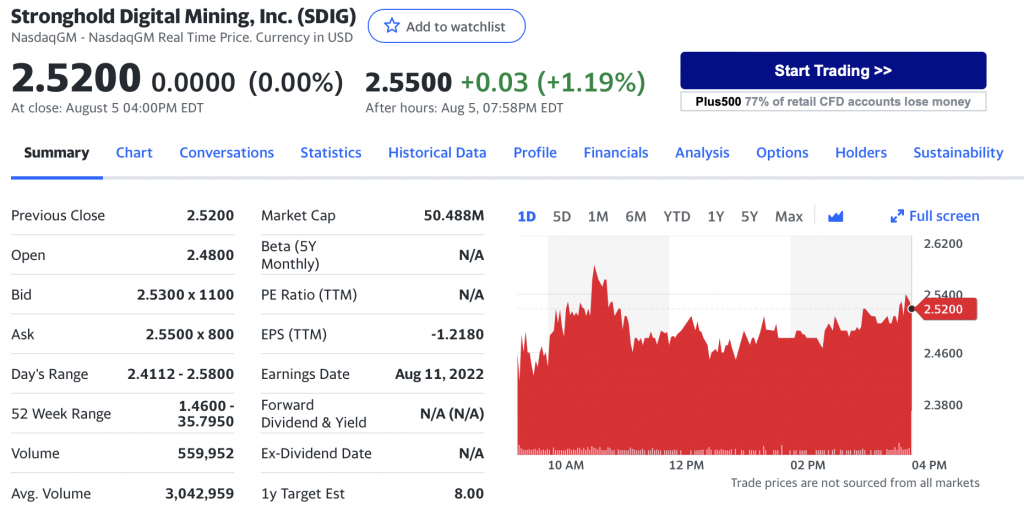
Stronghold Digital is the most cost-effective Bitcoin miner. The company is based in Pennsylvania and has built to steam-based electric generators recycling coals from the heavy industrialized state. With this infrastructure, they can mine at $ 3.648/BTC (~16%!). To give you some perspective, the market average is 50%. The high-cost efficiencies give them a bit tolerance against fluctuating BTC prices.
There are two very interesting aspects I like about Stronghold Digital:
- It generate SO much power that is able to sell it back to the network. This is one of the reason their costs are amongst the lowest in the industry.
- It has a cash position of $ 152 million, partially scheduled for further investments, partially for operational expenses for a 10-month runway.
Voyager Digital (VYGVQ)
Annual Report – https://sec.report/otc/company/id/631384
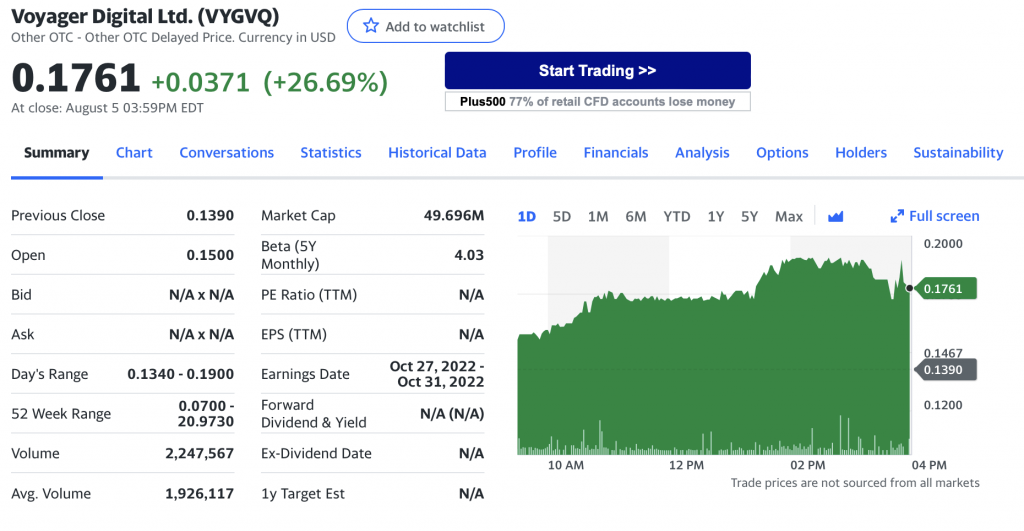
Voyager Digital struck me as one of the fastest growing mining corporations. They went from a revenue of $ 88 million in 2020 to $ 575 million in 2021. However, things have been a bit messier in the company.
Crypto Hedge fund Three Arrows Capital issued a loan of 15.320 BTC and $ 350 million to Voyager during the period of high growth and speculation in 2021. In the meantime, Three Arrows Capital went bust and has been ordered to liquidate as of June 2022. This is not at all surprising to me, since that one loan issued to Voyager was 52% of their exposure. :O I can tell you, as a fund manager, that is just dumb.
It is not yet clear what happened with the almost $ 700 million loan. Voyager claims they never even received that capital.
Voyager received a new capital injection after the failed adventure with Three Arrows Capital. This time by Alameda Research (Sam Bankman-Fried, FTX founder and CEO). With this new capital injection, the company has received $ 200 million and a credit facility of $ 15.000 BTC. In exchange, Alameda bought 11,6% of Voyager (at a valuation of $ 1,7 billion!).
Despite the hype, the new shareholder, and the new capital injection, the company has recently filed bankruptcy.
Summary
In a nutshell, miners are in a vulnerable position at the moment. Only 3/7 companies being in a great strategic position to make it until the halving event in May 2024. Another 3/7 with a weaker financial position that will force them either to sell their BTC or raise new capital. And 1/7 already bankrupt as a result of the massive speculation in the 2020-2021 period.
What needs to happen for miners to survive until the next halving?
Just to be clear: I am not just talking about a few miners surviving. For the assumption of BTC accumulation to hold, the mining industry will have to thrive!
• Low & stable energy prices
The increase in energy prices was the biggest driver of the reversal after the bubble in 2021. Miners are able to mine 1 BTC anywhere between $ 5.000 and $ 13.000. So with BTC prices dropping under $ 20.000 and energy prices doubling, their margins squeezed both top-down and bottom-up. Even if BTC remains around $ 20.000, by resolving the energy crisis we are facing, they will have more room to manage their operations until the halving event.
• BTC stable around $ 60.000
With BTC stabilizing around $ 60.000 in the course of 2023, miners can reach a healthy cruise-mode allowing them to prepare operations to optimize the halving and the transition to lower BTC rewards and more difficult mining operations. If this event happens, smaller miners will also be in a position to do so which will benefit the industry as a whole.
• Government Approval
This all theory will crumble the moment governments will ban mining, similar to what China did some time back. A ban has tremendous consequences not only for the temporary BTC price, but for the entire crypto ecosystem. Moving operations to another country is a HUGE effort that few companies can afford, it is capital-intensive and requires a lot of time.
Miners Overview
Corporation | Cash Position | Runway | Likely to Sell BTC | Risks |
|---|---|---|---|---|
BITF | $ 400 million | 16 months | Yes | Unfavorable share dilution (ATM) for extra capital |
BTBT | $ 49 million | 22 months | No | Successful move to the USA |
DGHI | $ 258 million | 47 months | No | Nothing in particular |
MARA | $ 116 million | 4 months | Yes | Access to additional capital |
RIOT | $ 462 million | 10 months | Not, if they use their credit facility | Realize planned cost-efficiencies |
SDIG | $ 152 million | 10 months | Yes | Access to additional capital while maintaining cost-efficiencies |
VYGVQ | – | – | – | Bankruptcy |
Newsletter
Stay up-to-date with the latest developments in the stock and crypto market., fund, and crypto market.
(function() { window.mc4wp = window.mc4wp || { listeners: [], forms: { on: function(evt, cb) { window.mc4wp.listeners.push( { event : evt, callback: cb } ); } } } })();
.form { position: relative; left: 50%; transform: translate(-50%); height: 50px; width: 500px; opacity: 0.5; }
.button { position: relative; left: 50%; transform: translate(-50%); background-color: #54595f; border: none; border-radius: 5px; box-shadow: 0px 8px 15px rgba(0, 0, 0, 0.1); width: 116.859; height: 45px; line-height: 15px; color: white; padding: 15px 32px; text-align: center; text-decoration: none; display: inline-block; font-size: 15px; margin: 4px 2px; cursor: pointer; font-family: "Roboto", Sans-serif; }
Disclosure
These are unqualified opinions, and this newsletter, is meant for informational purposes only. It is not meant to serve as investment advice. Please consult with your investment, tax, or legal advisor, and do your own research.




No comment yet, add your voice below!